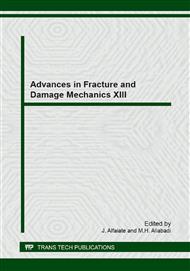p.285
p.289
p.293
p.297
p.301
p.305
p.309
p.313
p.317
Comparison of Artificial Neural Networks and the Transfer Function Method for Force Reconstruction in Curved Composite Plates
Abstract:
This paper presents two of the most recent approaches for impact force reconstruction, applied to a curved composite panel. The first one is based on the development of an artificial neural network, while the other on the evaluation of transfer functions in the frequency domain. Both methods provide advantages and disadvantages so that a detailed study should be conducted in order to determine which one can be considered more suitable for impact identification purposes. The aim of this paper is to present a comparison between these two methods, in particular when impacts on different surfaces of the plate are present. The main contribution is the application of the two approaches on a curved composite panel. The radius of curvature plays an important role in the contact force due to impacts on the inner or outer surface of the panel, introducing one more parameter in the reconstruction problem.
Info:
Periodical:
Pages:
301-304
Citation:
Online since:
September 2014
Authors:
Keywords:
Price:
Сopyright:
© 2015 Trans Tech Publications Ltd. All Rights Reserved
Share:
Citation:


